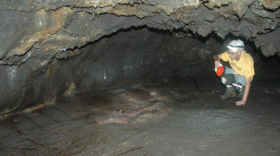The world’s most active volcano started erupting once again on Jan. 5. Kīlauea showed signs that magma was moving towards the surface of Halemaʻumaʻu crater. The Hawaiian Volcano Observatory assembled field crews to respond. Geologist Drew Downs is part of the team.
Speaking to The Conversation on Friday morning, Downs said he arrived at the crater just 30 seconds after the eruption started. He said scientists were not too surprised to see Kīlauea begin erupting again.
"Maunaloa and Kīlauea, as magma accumulates under the surface, they both inflate, they both deflate, and it's unclear exactly how those relate to each other and have an effect on each other's magma system," he said.
For about two weeks starting Nov. 27, Hawaiʻi had two volcanoes spewing lava side by side when Maunaloa erupted for the first time in 38 years. Both volcanoes stopped erupting at about the same time in December.
"As Maunaloa relaxed and stopped its eruption, it wasn't unsurprising that repressurizing this magma system, that it might have an effect on Kīlauea. There's still a lot of questions that need answered in that regard. But I think the data is now coming in and that we can have a stronger look at that and start coming up with a model," he told The Conversation.
To recognize Volcano Awareness Month, the volcano observatory will have a series of talks and outreach events on eruption preparedness over the next couple of weeks.
This interview aired on The Conversation on Jan. 6, 2023. The Conversation airs weekdays at 11 a.m. on HPR-1.




